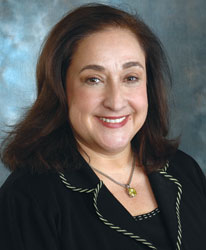Power to the People

Susan Tomasky, JD ’79, is president of AEP Transmission, a division of America Electric Power.
Susan Tomasky’s job is about power: how you get it, how you distribute it, and where you use it.
Tomasky, JD ’79, is president of AEP Transmission, a division of American Electric Power, one of America’s largest electricity corporations. She manages AEP Transmission’s 2,000 employees and 39,000 miles of electricity transmission lines in 11 states. She also is the lead champion for an AEP initiative calling for a nationwide, federally endorsed, high-voltage transmission system to meet America’s future energy needs.
“Americans are entering an era where we have to make very serious choices about energy, in terms of it being cleaner, renewable, and more efficient. The key to having this is a transmission system that goes where the energy resources are and transports electricity more efficiently to where the consumers are,” Tomasky explains.
Such a system, dubbed the “Interstate Electricity Highway,” may give America’s energy markets the kind of economic and efficiency advantages that the interstate highway system brought to commerce.
“Such a network would allow us to move from viewing energy resources as local commodities to viewing them as being available across the country. Consider renewable resources—wind is our most promising, but those resources are far from the customer. Without an interstate transmission system, wind energy won’t get to the markets that need it,” she says.
The events that placed a GW Law graduate into a job that could reshape America’s energy future began in Tomasky’s hometown of Morgantown, W.Va. She inherited from her parents a passion for politics and fostered these interests at the University of Kentucky, graduating with honors in political science in 1974. Then she turned toward Washington, D.C., to seek a law degree.
“It was an exciting time. I was on Capitol Hill during the Arab oil embargo when the United States was just forming its national energy policies. I found this intriguing, and after graduating from GW Law School in 1979, I got a job with the Federal Energy Regulatory Commission [FERC].”
Tomasky was at the FERC for two years then spent about 12 years with the D.C. law firm Van Ness Feldman, where she became a partner in 1986. She returned to the FERC in 1993 as general counsel and served in that role until 1997. Among her legal and policymaking responsibilities, she was actively engaged in the introduction of competition among the nation’s energy providers.
“This set me on a course of wanting to continue working in the industry. From FERC, I moved into private practice with Hogan & Hartson in D.C., working on various energy projects, including some for AEP. Ultimately AEP hired me in 1998 as an executive vice president and general counsel. Three years later, as problems at companies like Enron emerged, AEP’s chief executive officer asked me to become chief financial officer. I did this for five years and really enjoyed being involved in the restructuring and business sides of the company, rather than having a strictly legal job,” Tomasky says.
Her business experience further expanded through a two-year stint as executive vice president for AEP’s Shared Services, responsible for human resources, information technology and telecommunications, procurement, and supply-chain services. In January 2008 Tomasky became the president of AEP Transmission.
“It is a very interesting time to be in this business. My main responsibilities are to operate our current transmission system and develop a transmission business for our company that will be part of the new nationwide transmission infrastructure,” she says.
To build this infrastructure, Tomasky foresees two main challenges: fostering the public’s understanding of the need and obtaining required business and policy changes.
“People have to understand the enormous infrastructure behind the light switches in their homes. We have to make huge decisions to meet future challenges and build a transmission system that meets our economic needs and environmental health. This will require a political consensus,” she says.
The system, which will have to cross state lines, will need a federal authority to address concerns and make siting decisions, similar to how FERC works with interstate gas pipelines, she says.
“Finally, we’re going to need cost allocation for this system. Because the lines will go across large regions, we need to spread the costs of these facilities broadly as well.”
Tomasky enjoys participating in an effort of such national importance. She counts her involvement in pro-competition policies and moving the energy industry forward as her biggest accomplishments. She has also received international recognition. Rader Energy named her one of the world’s “50 key women in energy worldwide” in 2001 and 2002. In addition, she is on the board of the Keystone Institute, which focuses on the intersection of science and public policy.
Tomasky is civically active in the Columbus, Ohio, area where she, husband Ronald Ungvarsky, and their daughter, Victoria, reside. Her service has included membership on the boards of the Columbus Symphony Orchestra, United Way, Greater Columbus Chamber of Commerce, and Columbus School for Girls.
Asked how her GW law degree contributes to her success, Tomasky says: “The single most important thing I learned is to think like a lawyer: The analytical and discipline skills are critical in understanding how to get things done. The second thing is how GW taught me not just the law but that the law occurs in a social and political context—that there is a big picture to consider outside of the casebooks.”
—Kathleen Kocks
